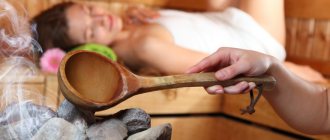Since ancient times, it has been customary in Rus' to treat any ailments in the bathhouse. And not only we, Russians, glorify it as a panacea for any disease. Our good neighbors, the Finns, also respect their sauna.
They even have a special saying that the bathhouse can be used by anyone who can reach it. And if the sauna did not help in treating the disease, then nothing will help the person...
A huge leap in science, the study and treatment of diseases with the help of modern medicines has pushed back the healing power of the bath. Of course, the cult of the bath is now completely different from what it was before. If previously colds, joint pain, back pain or ordinary fatigue were treated only in the heat of the bath, today we rush to the pharmacy for healing.
I am not calling for abandoning traditional methods of treatment and seeking salvation in the kingdom of the bathhouse. Alas, the bathhouse culture has been largely lost. But, for the prevention of diseases, and also as a faithful assistant to traditional medicine, the bathhouse is indispensable to this day.
The healing power of the bath
The healing power of the bath was studied by the well-known medieval Persian scientist Avicenna. He believed that the steam room could cure insomnia, headaches, migraines, paralysis and spasms. However, not all baths work the same. Although a Russian steam bath and a dry-air sauna are similar, their effects are different.
Not all people tolerate the wet steam of a bathhouse and the dry air of a sauna equally. The body's intolerance to temperature changes causes fatigue, tiredness and a negative attitude towards the entire bath culture. But it turns out that everything is quite simple - you need to choose the right temperature and humidity in the bath.
Wet steam bath
A real Russian bathhouse is a wet steam bath. Official medicine is a supporter of treatment in the Russian bath for the following ailments:
- Rhinitis
- Chronical bronchitis
- Gout
- Radiculitis
- Rheumatism outside the acute phase
- Pneumonia
- Neurasthenia
- Polyarthritis
- Kidney diseases
- Initial stage of hypertension
- Hypotension
Dry air bath
Although the sauna, or dry-air bath, is a close relative of our Russian bathhouse, its effect on our body is completely different. And visiting the sauna is recommended for the treatment of such diseases:
- Cystitis
- Skin diseases (eczema, dermatitis, psoriasis)
- Stones in the kidneys
- Liver diseases
- Inactive form of rheumatism
- Arthrosis
- Chronic colds
- Hypertension
- Dystonia
Of course, every disease has indications and contraindications; we cannot say that they are absolute. Baths and saunas are complex procedures; they are not limited to one steam session.
Regular use of a wide variety of rubs, compresses, ointments, taking healing tinctures, massage, aromatherapy, clay therapy, phototherapy and even dipping in cold water - all this is an additional part of any treatment in the bathhouse.
Otitis: what kind of disease
Otitis is an inflammatory process that covers the ear cavity. The disease can occur in acute and chronic form, the process can be catarrhal or purulent. The intensity of the symptoms of the pathological condition depends on the activity of the causative microorganism and the protective properties of the patient’s body.
Reference! Otitis media is the most common otolaryngological pathology among children. By the fourth year of life, more than 80% of children experience some form of impairment.
The list of reasons that provoke the development of the inflammatory process is as follows:
- spread of the pathological process throughout the ENT system;
- adenoid vegetations in children;
- damage to the auricle;
- hypothermia;
- decreased immune parameters;
- ear canal injuries;
- violation of hygiene rules.
The list of symptoms of otitis media includes the following:
- severe weakness;
- increased body temperature;
- headache;
- feeling of stuffiness;
- sensation of tinnitus;
- earache;
- decreased hearing quality, feeling of vacuum.
It is necessary to follow the treatment rules prescribed by a specialist; failure to comply with them can cause all sorts of consequences:
- various intracranial complications;
- perforation of the eardrum and spread of purulent exudate;
- cholesteatoma;
- inflammation of the mastoid process, accompanied by destruction of the auditory ossicles;
- disorders in the gastrointestinal tract;
- development of hearing loss.
Based on this information, we can conclude that otitis media is a dangerous disease and compliance with the basic rules of its treatment is a necessity. Drug therapy will lead to positive results, provided that the patient complies with simple auxiliary requirements.
How does a bath have a healing effect?
The sauna kingdom is not limited to just heat and steam. A whole army of positive factors is concentrated here! Caressing steam, the cradle of all life on Earth - water, healthy aromas and, of course, high temperatures.
Of course, all the bones are warmed up in the sauna! And this is achieved not only by warming the body with steam.
Thermal radiation from the heater provides wave heating of the body. Of course, we don’t notice this wave heating, but the force from the heated bath stones is considerable. Especially if the heater is filled with crimson quartzite or jadeite.
A steam room in a bathhouse with a broom cannot compare in efficiency with any other bath. In the steam room, the power of a broom, its targeted beneficial action treats ailments no worse than certified specialists.
I think that no one will dispute the fact that purity is a strong force. After all, it is cleanliness that the bathhouse gives us above all! Metabolic processes in the body are activated, blood circulation is stimulated, and the heated skin through the opened pores is actively cleansed of all uselessness.
With sweat, lactic acid (which causes fatigue), urea, metabolic end products, salts, etc. are released...
The body, freed from toxins, begins to work together and harmoniously. But, nevertheless, we get a huge, positive effect from emotional and mental relief. Many people associate the bathhouse only with positive emotions and traditions. Here the nervousness somehow goes away on its own and the tension is relieved.
Worries and adversities lose their significance and relevance. A positive attitude after a good steam room is a guarantee of a bath!
But you still need to know about contraindications to visiting baths and saunas...
Treatment of other diseases
The healing effect of the bath is not limited to this , because it also copes excellently with other ailments. Among them are varicose veins, since the bath strengthens the walls of blood vessels. It helps cope with skin diseases by cleansing pores and removing dead skin particles, improving skin condition even with psoriasis and neurodermatitis. The positive effect of a bath on sprains, bruises and dislocations in combination with the influence of a broom has been proven. Even with hemorrhoids, the bath helps by normalizing the outflow of venous blood.
And of course, bath procedures stimulate metabolism, so they effectively fight excess weight and normalize the functioning of the gastrointestinal tract. Moreover, clinics in the United States have discovered the positive effect of baths in the treatment of kidneys by normalizing water balance. The bath also helps the body quickly cope with the consequences of illness or surgery. Let’s not forget about the immunity that the bathhouse produces by powerfully enhancing the work of cells that guard the fight against viruses and infections.
Contraindications for visiting the sauna
The sauna sets temperature records with low humidity, the heat here is still that great! Even a completely healthy person sometimes feels ill from spending a long time in a dry, hot room. It is better to postpone visiting the sauna if you have:
- High blood pressure
- Tuberculosis
- Severe diabetes
- Chronic kidney disease
- Epilepsy
- Urolithiasis disease
- Upper respiratory tract diseases
- Atherosclerosis
- Glaucoma
Contraindications to baths and saunas are based on sensitivity to temperature conditions for various diseases, to the effects of humidity and thermal radiation. Pay close attention to the advice of specialists and your well-being during bath procedures. Our body is the most sensitive organization that can decide for itself what it likes and what is completely unsuitable...
Even the most avid bath lover involuntarily listens to his feelings during bath ceremonies and evaluates his well-being in different temperature conditions. A bathhouse is not a constant environment; a lot changes here - temperature, humidity, lighting...
The bathing kingdom can become both a healer and an enemy. A bathhouse can cure many diseases if you do everything “wisely,” because no one has ever done anything good in a hurry.
Please tell me! Is it possible to bathe a six-month-old child if otitis media begins?
Natalie Natalie
For otitis media, it’s good to make a compress: heat novocaine with vodka 1:1 in a water bath and put moistened cotton wool (just squeeze it out a little so that it’s not too wet) in the ear and then put more cotton wool on the whole ear to warm it (novocaine will numb the pain, and vodka will warm you up). Walnut oil also helps very well (you need to squeeze the oil out of the nuts (you can use garlic) and put 3 drops in each ear. My mother treated my brother this way. But it’s better not to bathe. So, rinse under the tap and that’s it. And be sure to Go to an ENT specialist. Ears are no joke. Get better.
Don't take risks. Go to the doctor!
Of course not, just rubbing
Big girls don't cry
You can bathe if you don’t have a fever (but it’s better to abstain and limit yourself to washing), but you can’t wash your hair. If a child has otitis media, then applying a compress is not only possible, but even necessary. The compress is strictly contraindicated for purulent otitis media.
Olga Ovsyannikova
It is possible, only with the door to the bathroom open, so that there is no sudden temperature change. You can also heat it, preferably with warm salt. I cured mine by dropping levomethicin alcohol on the doctor’s recommendation. And so that he wouldn’t suffer at night, the doctors advised either Efferalgan, or Panadol, or suppositories.
.
If there is no temperature, then you can bathe, but plug the ears with cotton so that no water gets in. If the otitis media is purulent, you should not heat it. And if there is no discharge from the ear, then they warm it with a blue lamp.
No, you can’t bathe as a last resort to prevent water from getting into your ears
It is not recommended to bathe when otitis media begins. A warming compress can be applied if there is no fever.
Causes
The human ear is a complex and at the same time fragile organ. Nature took care to protect him. Therefore, all the “main” parts of the auditory organ are located deep in the temple. And in order for a person to have the opportunity to hear sounds from the environment, there are two channels:
- External auditory canal - it conducts sound.
- Eustachian tube - it conducts air.
The external meatus ends with the tympanic membrane, which separates it from the middle ear area, and the Eustachian tube is the connecting zone between the middle ear and nose. In addition to supporting ventilation, it also regulates pressure on both sides of the membrane, which ensures proper sound transmission.
For modern people, inflammation of the throat and nose, the so-called cold, is a common thing, and it is clear that the auditory tube is precisely the passage for various viruses and bacteria into the hearing organs. As soon as immunity decreases, for example, during hypothermia, the ears are immediately attacked by them.
The risk group for inflammatory processes in the ear includes people exposed to sudden changes in pressure, such as climbers or divers, as well as those who have experienced mechanical damage.
The auditory organ is divided into different sections and each of them performs a specific function. The concha and ear canal capture sounds and transmit them to the eardrum. That, in turn, “converts” these sounds into vibrations and transmits them to the middle ear. In the inner ear there is a cochlea, where these vibrations are converted into nerve impulses, and the organ of balance - the labyrinth, which is located next to the cochlea, transmits data to the brain about the position of the body in the environment.
Now you need to understand what otitis media is. In simple words, this is ear inflammation. It can be acute or chronic. It can be purulent or catarrhal. It all depends on the state of the patient’s immunity and on the severity of the pathology development process itself.
According to anatomical features, the disease is classified as external, middle and internal. The patient’s condition and symptoms depend directly on which department the disorder appears in.
Otitis externa can be in the form of a boil or local inflammation on the surface of the ear canal. Hearing is not lost during these inflammatory processes, but pain will occur when chewing or talking. Sometimes the process is accompanied by an increase in temperature. After the boil matures, it opens on its own and the patient’s condition improves. The cause may be infections that penetrate into the ear canal cavity.
There is a distinction between diffuse otitis externa, which, as a rule, is a complication of a chronic purulent disease of the middle ear. With this pathology, the eardrum is damaged, and infection with purulent discharge penetrates into the tissue of the external auditory canal.
What consequences are possible?
The list of possible consequences includes various complications of otitis media, the likelihood of which increases significantly if the patient does not comply with the basic rules and regulations regulated by the attending physician when determining the therapeutic regimen.
The list of possible consequences that arise when visiting a bathhouse includes:
- Intracranial complications. The risk of developing meningitis and sepsis increases significantly against the background of increased proliferation of pathogenic microflora.
- Blockage of the Eustachian tube due to displacement of purulent and serous masses.
- A sharp progression of the disease, accompanied by the involvement of other ear structures in the process.
Based on knowledge about the likely consequences of the development of the disease, we can conclude that visiting a bathhouse during inflammation is possible only during the recovery period.
Experts' opinion
The question of the advisability of visiting a bathhouse for inflammation of the hearing organs is considered by a specialist, taking into account the characteristics of the course of the lesion in a particular patient.
The main goal of this procedure, according to doctors, is to reduce pain while restoring blood circulation in the affected organ. Against the background of heat, the process of blood vessels is activated, the permeability of the wall increases, and pain is eliminated. At the same time, visiting the steam room is strictly prohibited during the acute period of the disease. The procedure is also prohibited for purulent otitis media.
Doctors report that the expected benefit is less significant when considering the possible harm from the thermal procedure, therefore it is better to treat otitis media traditionally.











